Check in early and stay late during OnMilwaukee's "Hotel Week" sponsored by VISIT Milwaukee. The next seven days will be packed with stories about historic area hotels, reviews, history, food and drink, staycations and more. Find out what it's like to be a tourist in this town. (Chocolate on your pillow not included.)
Hotel Wisconsin, 720 N. Old World Third St., is a survivor. While Downtown once brimmed with hotels of all stripes – from swanky to rundown, from residential to aimed at visitors – very few of them survive from the early part of the 20th century.
These days, the 12-story building is home to more than 100 apartments (all but two of which were leased when I visited), created after the hotel closed in 2003, in a $23 million renovation.

The renovation created new apartment layouts while maintaining the original corridors and doors (the transoms are covered, but remain), as well as the lobby and ballroom on the second floor. The former entertainment space in the lower level was converted to parking, and of the two commercial spaces one is currently rented by a convenience store.
The renovation really returned a luster to the building, which had faded over the decades.

Apparently designed by the Chicago firm of Holabird & Roche (the October 1912 building permit below names Kirchhoff & Rose as architects, but floor plans dated June 1913 – after a change in the plans – bear the stamp of Holabird & Roche), the Hotel Wisconsin opened on Oct. 8, 1913.
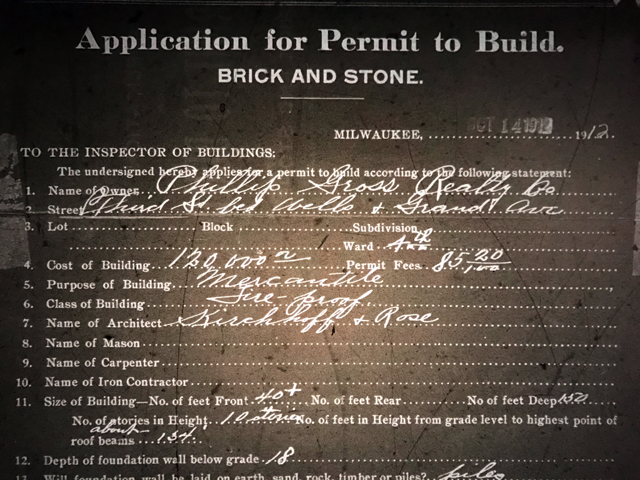
It replaced an earlier building on the site that was razed to make way for the new structure, which was built for the Phillip Gross Realty Co. at an initial cost estimate of $120,000.
Milwaukee's Schroeder & Son provided funds for the refinancing of an $800,000 bond issue for the then new Hotel Wisconsin, which was the largest hotel in Wisconsin at the time, and so Walter Schroeder launched what would become a chain of Wisconsin hotels (with one in Duluth, too).
The new hotel was a big deal. The $2 million luxury property rented its rooms at "popular prices," from a buck on up. This reportedly led a crowd of 2,000 people to come see it for themselves on opening day.
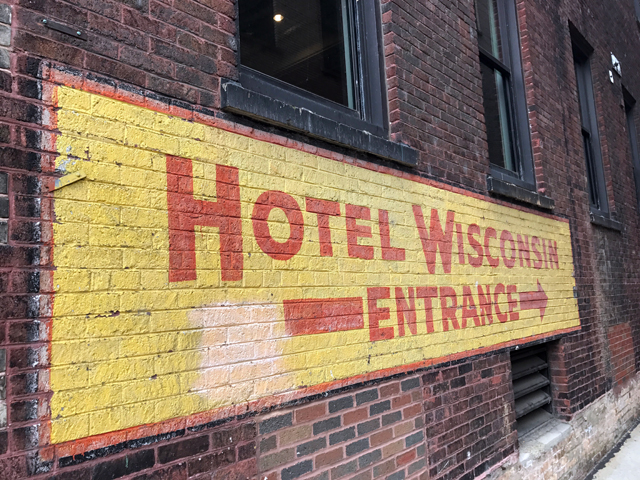
One newspaper reported that at 6 p.m., Gov. Francis McGovern opened the hotel’s doors with the press of a button from his desk at the State Capitol. Within a few hours more than 10,000 people were said to have stopped in to check out the new hotel.
On the outside, it was unusual. You don’t see many buildings this tall with gables and a pitched roof, as if it were a private residence. The red brick facade is decorated with terra cotta and white brick elements.
In his "Heritage Guidebook," Russell Zimmermann noted that the building was enlarged before it was even completed.
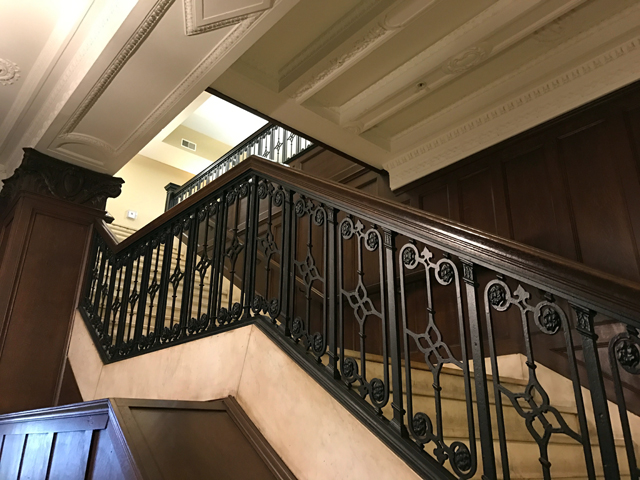
"Although originally planned as a 375-room hotel, the developers Arthur and Harold Richards, acquired an adjoining site after the steel frame was already up and expanded the capacity to 500 rooms," he wrote.
Permits held by the city reflect this change. In September 1913, an inspector noted, "this building was not built as originally planned. A permit was issued April 28, 1913 using this site as an enlargement of the Wisconsin Hotel." (It is likely at this point that the Chicago architects were brought on board.)

Eleven years later, the hotel's owners again tapped Holabird & Roche to build a five-story annex to the hotel just across the alley. Again, an existing building was razed to make way.
That building still stands and most recently housed Rusty’s Old 50 nightclub. Plans to build a skywalk across the alley to connect the buildings appear to have gone unrealized.
Over the years, many famous people stopped over at the Hotel Wisconsin, including first lady Eleanor Roosevelt and comedy duo Laurel & Hardy.
The hotels retail spaces housed an array of tailors, shoe stores, coffee shops and other businesses across the decades, too.
Countless Milwaukeeans and visitors to town dined or imbibed in the Colonial Room, the Badger Room, the kitschy Circus Room and the Blackamoor Room.
Pioneering Milwaukee Journal advice columnist Ione Quinby Griggs was reportedly the hotel's longest resident, having called the Wisconsin home for more than 50 years. "The staff of the Hotel Wisconsin was 'very devoted to her' for decades," wrote authors Genevieve McBride and Stephen Byers in their 2014 biography, "Dear Mrs. Griggs: Women Readers Pour Out Their Hearts from the Heartland."
By the 1930s, the hotel had become part of the Schroeder family of hotels and by the second half of the 1950s it was owned by Sol Blankstein's eponymous investment company. Blankstein owned the building at least into the mid-1990s, if not until the hotel closed in 2003.
By the time I first came to know the place in the early 1980s, it had appeared to have become a pretty gritty residential hotel that still rented rooms to travelers.
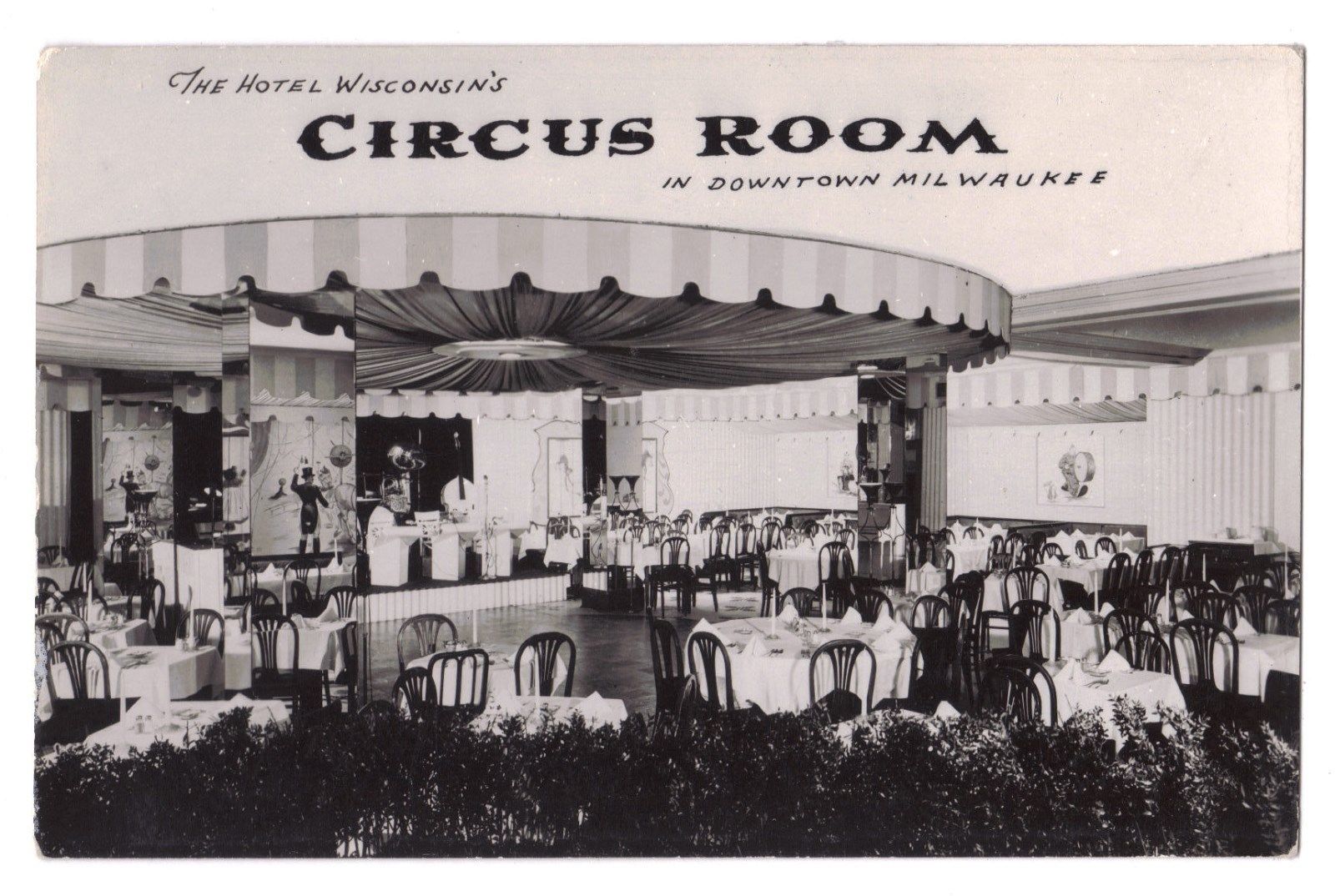
In the basement C-Club – which I think had been the Circus Room (and was called the Badger Cafe when the hotel opened, according to a 1913 Construction News article) – I saw a handful of great, intimate reggae shows with top Jamaican acts like Burning Spear, The Meditations, The Mighty Diamonds and Michael Rose (of Black Uhuru).
Paul Finger, best known to many as the frontman of Wild Kingdom, hosted packed-house ska record spins. I even played there once in a band and the opening act, we discovered as we loaded our gear down the stairs, were topless dancers. Later that space hosted a club called Mr. Buster's.
In 1966, the subterranean space had been home to Five Fingers, a teen club with live rock and roll music, operated by Burt Sinagub, who after playing with The Jacks had formed The Bel-Airs, a group that bridged rock and doo-wop and released a much sought-after 45 on Sara Records in 1963. His partner was Lawrence Tarnoff.
The private club (you can see video here!), which featured caged go-go dancers, opened in June and appealed to suburban kids, who, the owners said, had fewer entertainment options than city kids. It was, they added, also an attempt to keep out a tougher city crowd. After quickly igniting controversy, the club's membership was opened to teens across Milwaukee County, the city included.
Five Fingers was short-lived at the hotel, moving in October to a new space at 513 N. Broadway.
By the 1990s, the commercial space just upstairs at street level was operating as Cafe Melange. Owner Larry Krueger remembers:
"The restaurant/bar had been closed when I opened Cafe a melange in 1987. It had been several places throughout the years. Melange served lunch and dinner and hosted a variety of different entertainment: Poets Monday, the Hip Waders, John Schneider & Orchestra – music of the '20s, '30s and '40s – Bloomberg and Mahaffey's original music and music satire, LaChazz, Mrs. Fun, and numerous theatrical productions including the stage productions of old radio scripts, shows by the theater group Boulevard Ensemble, and also hosted the Wisconsin Public Radio program, 'Hotel Milwaukee,' plus numerous traveling performers. Quite a fun variety."
"We had a mix in our menu. Entrees like grilled salmon with teriyaki glaze, steaks, sautéed shrimp and pasta, and vegetarian and sandwiches. I have great memories of of Cafe Melange and the wonderful people that worked, performed and frequented it as customers. I was blessed to know them and learned a lot. Would not trade it for anything, but it was a huge amount of work. Cafe Melange closed in 1997 when the building was sold to a French developer."
A former employee recalls a gay club called the Oberons hosting dinner parties in the old Badger Cafe/Circus Room/C-Club space, catered by Cafe Melange, during the 1990s. In 1913, when the place opened, there was a large barber shop just off the Badger Cafe basement lobby.
After the hotel closed in 2003, Les Wuertz and the Hotel Wisconsin Co. LLL, renamed the place The Grand Wisconsin and set about converting it to upscale apartments. Some of the units are duplex apartments and many have lovely views of Downtown.
Rents range from $1,100 for the smallest one-bedroom on the lowest floors to about $3,000 for 2,200-square-foot units up top.

In the basement, the old C-Club was converted to parking – though the tile floor survives in large part, making it perhaps the coolest underground parking lot in town – and what had served as the backstage area across the corridor is now a fitness center and pool.
The second-floor ballroom was, in 1913, "finished in white and gold," according to the Construction News article. "It is modeled after the royal splendor of the Louis XIV reign. The ornamentation is richly conceived and carried out in beautifully curved lines. Floor coverings are royal red, dainty gold-enameled chairs and sparkling glass electroliers carry out a gorgeous decorative effect."
The room – now called the Blackamoor Room, though it appears unlikely the same space that housed the hotel's earlier Blackamoor Room – was renovated and its beautiful ceiling restored.
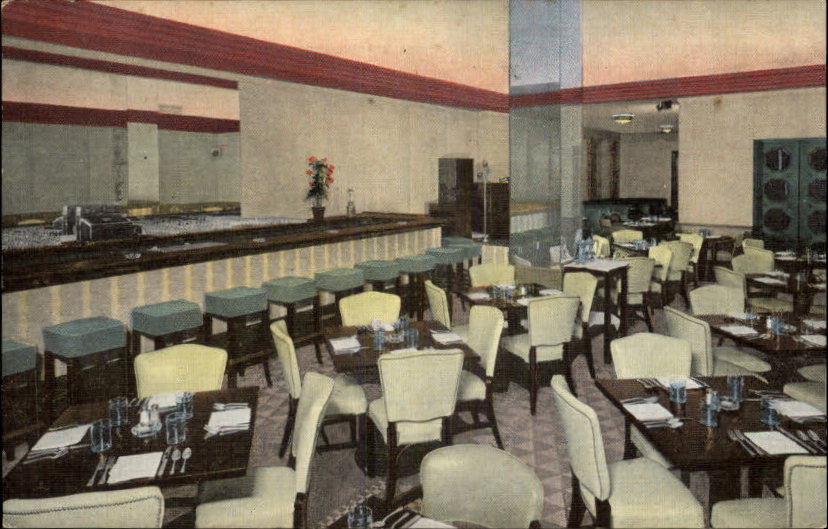
Comparing old images with the current space, suggests that the Blackamoor Room was downstairs in what was later Cafe Melange and is now the vacant commercial space. The tiled floors match, as does the placement of the supporting pillars.

Compare this floor to the postcard of the Blackamoor Room above.
The former Cafe Melange space is largely empty and torn apart, though an area toward the back is a place where residents can play with their dogs.
This is a fun place to explore, however, because layers of history remain here. On one wall there is classy dark wood paneling with fruit-garland ornaments dangling. On a pillar there’s wallpaper that appears to be hand-painted.
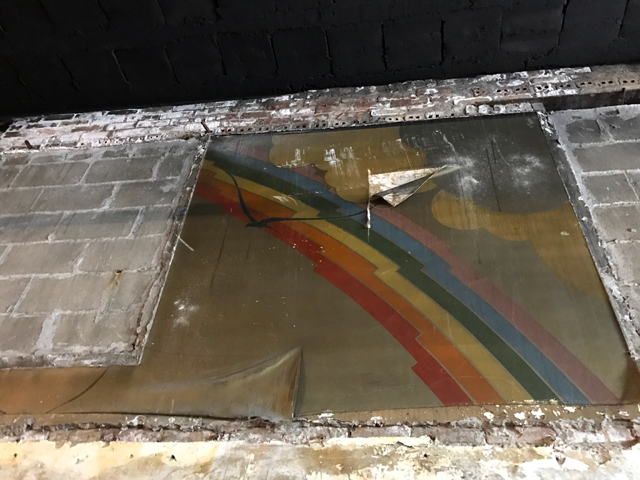
On another wall, there’s a painting of a rainbow that shouts 1970s.
Though the Construction News article misstates its location, the back portion of this space was "The Grille room, an interesting salon.
"It is in reality an Indian room, being finished in natural cypress wainscoting extending to eight feet above the base with spear heads stained in the wood. The ceiling is painted to resemble Indian blankets, while the Mosaic floor displays a like effect. The ornamental plaster cornice has Indian ornaments in its relief and is highly colored."
The front part of what was later Cafe melange was taken up by two retail spaces and the middle portion housed a lobby newsstand.

Across the lobby is a billiards room and lounge space that – like most of the public spaces in the building – have elaborate plasterwork ceilings. According to that 1913 Construction News article, this space was the ladies cafe.
Intriguingly, just to the west of the billiards room is a space that can’t be accessed from inside the building anymore, but that has three windows facing the alley.
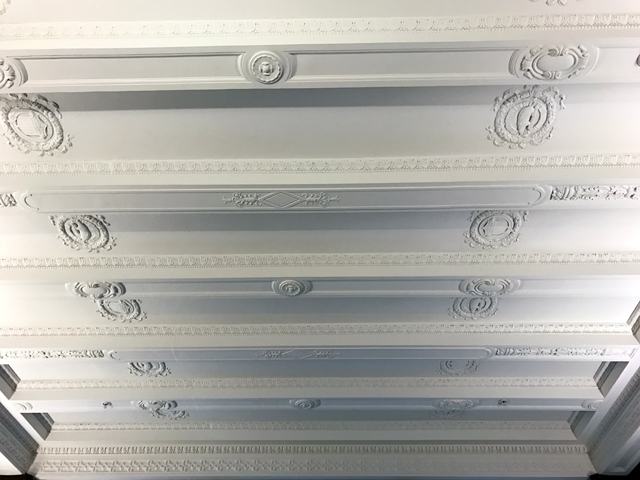
Most stunning of all, unsurprisingly, is the lobby. Here, the beamed plaster ceiling is dotted with American flag shields and images of badgers. There are terra cotta State of Wisconsin shields and leaded glass panes bearing the state shield, too.
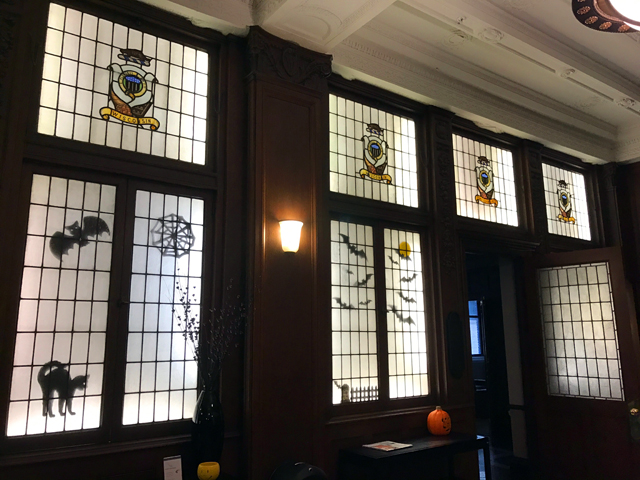
The original front desk with key and mail slots remains, and there are old hotel and other Milwaukee images framed on the walls, which have that same warm wood paneling.

And the tilework everywhere – as well as the marble staircase up to the ballroom – is pretty eye-catching, too.
After having only really experienced the inside of the Hotel Wisconsin during what was a down era for the place, seeing it now all sparkling and bright makes me appreciate what drew 10,000 folks to check it out on opening day ... and to imagine the kind of beautiful place they got to see.
Born in Brooklyn, N.Y., where he lived until he was 17, Bobby received his BA-Mass Communications from UWM in 1989 and has lived in Walker's Point, Bay View, Enderis Park, South Milwaukee and on the East Side.
He has published three non-fiction books in Italy – including one about an event in Milwaukee history, which was published in the U.S. in autumn 2010. Four more books, all about Milwaukee, have been published by The History Press.
With his most recent band, The Yell Leaders, Bobby released four LPs and had a songs featured in episodes of TV's "Party of Five" and "Dawson's Creek," and films in Japan, South America and the U.S. The Yell Leaders were named the best unsigned band in their region by VH-1 as part of its Rock Across America 1998 Tour. Most recently, the band contributed tracks to a UK vinyl/CD tribute to the Redskins and collaborated on a track with Italian novelist Enrico Remmert.
He's produced three installments of the "OMCD" series of local music compilations for OnMilwaukee.com and in 2007 produced a CD of Italian music and poetry.
In 2005, he was awarded the City of Asti's (Italy) Journalism Prize for his work focusing on that area. He has also won awards from the Milwaukee Press Club.
He has be heard on 88Nine Radio Milwaukee talking about his "Urban Spelunking" series of stories, in that station's most popular podcast.







